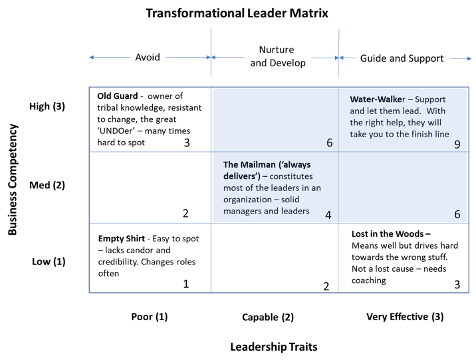Finding the ‘Right’ Transformational Leader
May 25, 2020 | by Bryan Ward
Organizational success during significant change is dependent on several factors. Assigning the ‘right’ leader to drive that change is one of the most critical factors. Transformational leaders must have the ideal mix of competencies in leadership and business.
The matrix below shows the relationship between Leadership Traits and Business Competence. The ideal transformational leader resides in the upper right box—he or she possesses both the knowledge and capability to effectively lead. The shaded area shows the best mix of these qualities.

We face change every day. Whether it is technology, our environment, or an awful pandemic—we must respond and adapt to these changes. Likewise, companies must continually change and adapt to market and customer needs. These changes can come in many forms—new technology, a merger, a Lean Six Sigma Transformation, an ERP implementation, and the like. To successfully weather these changes, fate favors the prepared. How can an organization prepare for change?
Successful Change
Over the last twenty years the CBS Team—as leaders, participants, and consultants—has witnessed many changes. Some of these large-scale changes were well done; however, most were not. Several key ingredients are needed to make these organizational changes successful. An organization will need:
- A committed leadership team with an active role in governance and support of the effort
- A structured, detailed implementation plan
- Consistent and competent change leadership to drive the change
We will address each of these in a series of articles. Here, we will focus on the last ingredient—the competent change leader.
How do we find these competent change leaders? Where do we look? What qualities and capabilities should they have? Can they be developed? From our experience, competent change leaders must possess a mixture of competencies in leadership and business to be successful. Specific competencies must be identified by the organization based on the required change—however, here is a list of critical competencies to ensure success.
Leadership Competencies
Qualities that make leaders competent change agents include:
- Humility—A demonstrated ability to listen. These leaders value others’ opinions and can change direction, if necessary.
- Judgement—The ability to quickly assesses risk and make decisions.
- Drive self-motivation—The ability to operate autonomously and act decisively. These leaders look for success from previous assignments or roles. Did this leader ‘own’ the assignment? Or, was this another waypoint to the next assignment or promotion?
- Charisma—The ability to inspire others with a clear plan and vision. These leaders must gain respect from their teams through trust and true caring. Look for your Servant Leaders in your organization. These leaders care more about their people than their own self-interests.
Business Competencies
We also look for business competency and experience. Leadership traits and business competence are different. Business competence is often skills-based. It is typically a function of talent, experience, and a capacity to learn. When in a transformation, competent business leaders have a certain depth of knowledge for their particular industry. Competence can be taught and coached though these traits are personal and can be more challenging to modify in adults.
Critical business competencies include:
- Business Acumen—Knowledge of the business, critical processes and the politics that make the organization run.
- Analytical Thinking—The ability to master a pattern of structured, methodical thinking and solve problems efficiently.
- Communication—The ability to communicate across all levels of the organization through multimedia, such as e-mails, presentations, oral and written directives and more.
- Systems-Thinker—The ability to understand the business, the market, the people, and most importantly, how it all connects—how changes in one process will affect other processes.
These qualities sound like ‘Motherhood’ and ‘Apple Pie’—qualities we should seek in all leaders. The combination of both high competency and effective leadership traits is unique and hard to find. If possible, transformational leaders should be selected from within the organization because oftentimes new hires lack credibility and can struggle with the task of driving meaningful change in an organization.
Additionally, executive leadership must be committed to the change or transformation. Without help and support from above, transformational leaders will fail. And lastly, this role of transformational leader cannot be misconstrued as a ‘career-ender’ or a ‘special project.’ This kind of thinking will destroy the change effort and the credibility of the transformation’s leader(s).
Blog Posts
Balancing Supply and Demand: Key to Business Performance
Uncover Hidden Cost Savings in Your Overhead Processes
Aligning Sales and Operations for Sustainable Growth
Harnessing the Power of Leader Standard Work
Unleash Your Operational Efficiency with Lean
Operational Turnaround Strategies: Transforming Underperforming Assets into Value Drivers
Operational Metrics and KPIs: Guiding Success in Buy and Sell Decisions
What to Do about Your Supply Chain Problems
Navigating High Interest Rates: Strategies that Actually Work
The 3 Crucial Steps to Fast, Efficient Operational Due Diligence
Join our community.
Sign up now to receive future news.
